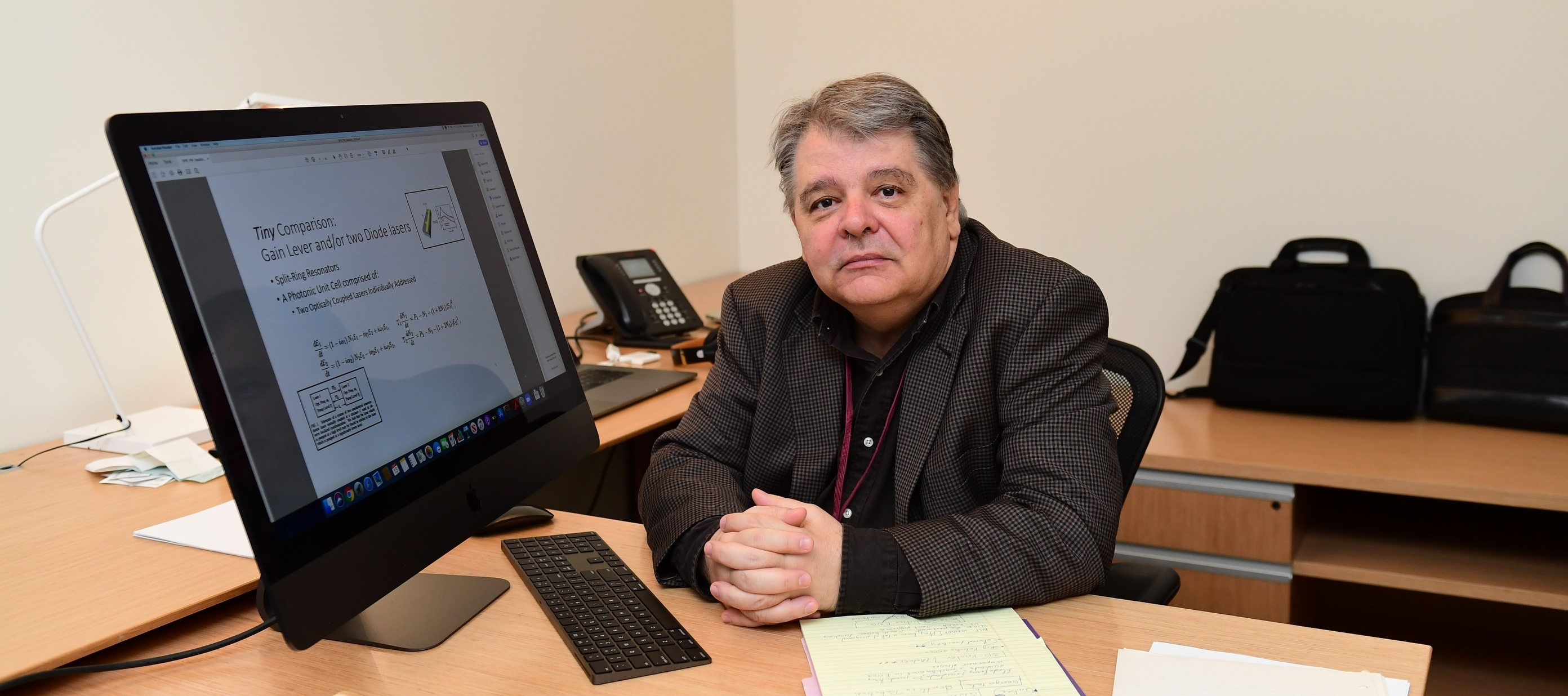Vassilios Kovanis: Expanding Master’s Programs and Shrinking Clocks

Vassilios Kovanis
- Joined ECE June 2019
- Professor and chair, Physics Department, Nazarbayev University, 2014 - 2019
- Air Force Research Lab, Photonics Technology Branch, 2005-2014
- Associate professor, Applied Mathematics Department, Rochester Institute of Technology, 2003-2005
- Program manager, BinOptics Inc, 2002-2003
- Senior research scientist, Corning Inc., 2001-2002
- National Research Council Fellow, 1992-1994
- Air Force Weapons Laboratory at Kirtland Air Force Base, 1989-2000
- Ph.D., theoretical physics, the University of New Mexico, 1992
Expanding Master’s Programs and Shrinking Clocks
With ECE’s footprint set to grow dramatically in Northern Virginia, Vassilios Kovanis is at the center of the expansion—coordinating with the state, other campuses, and tech companies to recruit students and design a new curriculum.
“We are scanning hundreds of student applications for talent to bring in,” says Kovanis, who was appointed Director or the Master of Engineering program (Northern Virginia) and collegiate professor in June 2019. “At the same time, we are doing searches for new faculty to join the enterprise up here in Arlington and in Blacksburg, as well as administrators. Everything is growing.” With almost 20 faculty members, the ECE program in Arlington is already the size of a small department, he notes.
Virginia wants 50% of the new engineers graduating through the expansion to be from Virginia. To help meet this goal, Kovanis explains, “We are working to understand the local population and the students from other Virginia institutions, and determine how they will enter and be successful.”
Attracting local students is a unique challenge for Kovanis, who is an experienced academic administrator. Before joining Virginia Tech, he spent five years as the Chair of the Physics Department of Nazarbayev University, a rapidly growing US-style university founded in 2010 in Kazakhstan that is aiming to become the model for higher education and research institutions in Central Asia.
Kovanis also has more than thirty years of experience in research and development environments, primarily at the Air Force Research Lab in Dayton, Ohio, but also at start-ups and established corporations. Throughout this period, he taught intermittently at the University of New Mexico and the Rochester Institute of Technology. “I’ve spent most of my time in defense. I’ve also done an international assignment, and now I’ve come very happily back to our nation’s capital,” he summarizes.
One aspect of ECE’s growth that he finds particularly exciting is the interest in computer engineering. “Historically electrical engineering departments do electrons and photons and devices. Here we have completely moved on to managing bits in computer engineering. The next step is possibly heavily relying on artificial intelligence and machine learning, and maybe quantum engineering. Maybe we’ll be working on cubits soon,” he says.
Last semester, he taught research and design methods for engineers.
Photonic Clocks
On top of teaching and overseeing the expansion of the M.Eng. program in northern Virginia, Kovanis is continuing his own research. “I have been trying for the last 30 years to take simple semiconductor lasers and make them faster and tunable.” Through this research, he is developing composite device oscillators and photonics clocks that achieve very high performance but are a fraction of the size of previous technology.
Most recently, Kovanis has been revisiting optical injection locking in semiconductor lasers. “We want to look at optical power spectrum shapes, to look at regions that were historically considered dead—they didn’t have any stability or interest – called exceptional points,” he explains, continuing, “We started actually looking at the systems to understand instabilities, and now we have discovered unusual, highly ordered regions.”
The main application of this work is photonic clocks. “Clocks exist everywhere. You can recount our civilization with the performance of clocks,” he says. Photonic clocks use light oscillations at the rate of trillions per second to vastly improve the accuracy of time measurement and could be used throughout electronics. “They can be inserted in any kind of frequency timing application,” Kovanis observes.
Traditionally, photonic clocks have been very large. “You have laser beams going back and forth over 4 km,” he notes. With new research, their size is being reduced dramatically. “When you have something very large on a tabletop, or on different mountains, how can you make it small but keep the performance?” he asks. “You have to redo the physics and perform high quality engineering. That’s a classic challenge: make it small, keep all the performance.”
Kovanis, who trained and worked for most of his career as a physicist, now works primarily in applied physics with collaborators in electrical engineering. “At the end of the day, we are academics. The main thing we do is generate scholarship. We’re not putting devices on the market. We’re educating the next generation of researchers,” he says, adding, “One of the successes of Virginia Tech is that it has very strong engineering students that have populated defense and other industries here in northern Virginia. You have Virginia Tech alumni hiring Virginia Tech students. That’s very powerful.”


